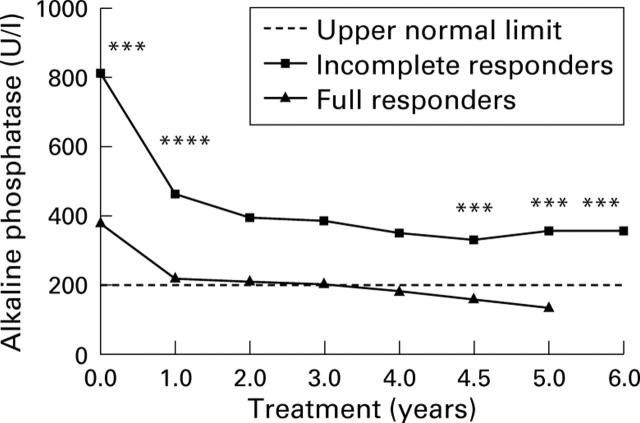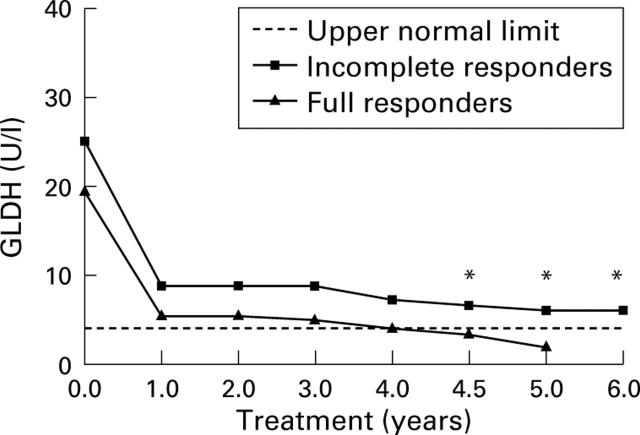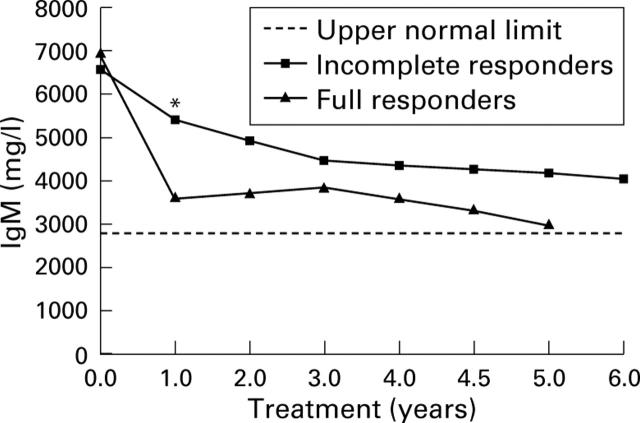Abstract
BACKGROUND—In some patients with primary biliary cirrhosis, ursodeoxycholic acid causes full biochemical normalisation of laboratory data; in others, indexes improve but do not become normal. AIMS—To characterise complete and incomplete responders. METHODS—Seventy patients with primary biliary cirrhosis were treated with ursodeoxycholic acid 10-15 mg/kg/day and followed up for 6-13 years. RESULTS—In 23 patients (33%) with mainly stage I or II disease, cholestasis indexes and aminotransferases normalised within 1-5 years, except for antimitochondrial antibodies. Histological findings improved. Indexes were not normalised in 47 patients (67%) although the improvement of their biochemical functions parallelled the trend in the first group. In these incomplete responders histological findings improved to a lesser extent. The only difference between the two groups before treatment was higher levels of alkaline phosphatase and γ glutamyl transpeptidase in the incomplete responders. At onset of treatment the discriminant value separating responders from incomplete responders was 660 U/l for alkaline phosphatase and 131 U/l for γ glutamyl transpeptidase. One year later it was 239 and 27 U/l (overall predictive value for responders 92%, for incomplete responders 81%). There were no differences between the two groups concerning immune status, antimitochondrial antibody subtypes, liver histology, or any other data. HLA-B39, DRB1*08, DQB1*04 dominated in both groups. CONCLUSIONS—In patients with mainly early stages of primary biliary cirrhosis, higher values of alkaline phosphatase and γ glutamyl transpeptidase are the only biochemical indexes which allow discrimination between patients who will completely or incompletely respond to ursodeoxycholic acid treatment. Keywords: primary biliary cirrhosis; prognostic indexes; full response to ursodeoxycholic acid; incomplete responders; anti-p53 autoantibodies; HLA typing
Full Text
The Full Text of this article is available as a PDF (107.2 KB).
Figure 1 .
Alkaline phosphatase concentrations during ursodeoxycholic acid (UDCA) treatment. ***p<0.001, ****p<0.0001 (since incomplete responders were treated for a longer period of time, the six year value was compared with the five year value of full responders).
Figure 2 .
Glutamate dehydrogenase (GLDH) concentrations during ursodeoxycholic acid (UDCA) treatment. *p<0.05 (since incomplete responders were treated for a longer period of time, the six year value was compared with the five year value of full responders).
Figure 3 .
Alanine aminotransferase (ALT) concentrations during ursodeoxycholic acid (UDCA) treatment. *p<0.05, **p<0.01 (since incomplete responders were treated for a longer period of time, the six year value was compared with the five year value of full responders).
Figure 4 .
IgM levels during ursodeoxycholic acid (UDCA) treatment. *p<0.05 (since incomplete responders were treated for a longer period of time, the six year value was compared with the five year value of full responders).
Selected References
These references are in PubMed. This may not be the complete list of references from this article.
- Angelopoulou K., Diamandis E. P., Sutherland D. J., Kellen J. A., Bunting P. S. Prevalence of serum antibodies against the p53 tumor suppressor gene protein in various cancers. Int J Cancer. 1994 Aug 15;58(4):480–487. doi: 10.1002/ijc.2910580404. [DOI] [PubMed] [Google Scholar]
- Bein G., Gläser R., Kirchner H. Rapid HLA-DRB1 genotyping by nested PCR amplification. Tissue Antigens. 1992 Feb;39(2):68–73. doi: 10.1111/j.1399-0039.1992.tb01909.x. [DOI] [PubMed] [Google Scholar]
- Ben-Ari Z., Dhillon A. P., Sherlock S. Autoimmune cholangiopathy: part of the spectrum of autoimmune chronic active hepatitis. Hepatology. 1993 Jul;18(1):10–15. [PubMed] [Google Scholar]
- Bengtsson B. O., Thomson G. Measuring the strength of associations between HLA antigens and diseases. Tissue Antigens. 1981 Nov;18(5):356–363. doi: 10.1111/j.1399-0039.1981.tb01404.x. [DOI] [PubMed] [Google Scholar]
- Beuers U., Throckmorton D. C., Anderson M. S., Isales C. M., Thasler W., Kullak-Ublick G. A., Sauter G., Koebe H. G., Paumgartner G., Boyer J. L. Tauroursodeoxycholic acid activates protein kinase C in isolated rat hepatocytes. Gastroenterology. 1996 May;110(5):1553–1563. doi: 10.1053/gast.1996.v110.pm8613063. [DOI] [PubMed] [Google Scholar]
- Bonnand A. M., Heathcote E. J., Lindor K. D., Poupon R. E. Clinical significance of serum bilirubin levels under ursodeoxycholic acid therapy in patients with primary biliary cirrhosis. Hepatology. 1999 Jan;29(1):39–43. doi: 10.1002/hep.510290140. [DOI] [PubMed] [Google Scholar]
- Christensen E., Neuberger J., Crowe J., Altman D. G., Popper H., Portmann B., Doniach D., Ranek L., Tygstrup N., Williams R. Beneficial effect of azathioprine and prediction of prognosis in primary biliary cirrhosis. Final results of an international trial. Gastroenterology. 1985 Nov;89(5):1084–1091. doi: 10.1016/0016-5085(85)90213-6. [DOI] [PubMed] [Google Scholar]
- Combes B., Carithers R. L., Jr, Maddrey W. C., Lin D., McDonald M. F., Wheeler D. E., Eigenbrodt E. H., Muñoz S. J., Rubin R., Garcia-Tsao G. A randomized, double-blind, placebo-controlled trial of ursodeoxycholic acid in primary biliary cirrhosis. Hepatology. 1995 Sep;22(3):759–766. [PubMed] [Google Scholar]
- Dickson E. R., Grambsch P. M., Fleming T. R., Fisher L. D., Langworthy A. Prognosis in primary biliary cirrhosis: model for decision making. Hepatology. 1989 Jul;10(1):1–7. doi: 10.1002/hep.1840100102. [DOI] [PubMed] [Google Scholar]
- Goodman Z. D., McNally P. R., Davis D. R., Ishak K. G. Autoimmune cholangitis: a variant of primary biliary cirrhosis. Clinicopathologic and serologic correlations in 200 cases. Dig Dis Sci. 1995 Jun;40(6):1232–1242. doi: 10.1007/BF02065530. [DOI] [PubMed] [Google Scholar]
- Güldütuna S., Deisinger B., Weiss A., Freisleben H. J., Zimmer G., Sipos P., Leuschner U. Ursodeoxycholate stabilizes phospholipid-rich membranes and mimics the effect of cholesterol: investigations on large unilamellar vesicles. Biochim Biophys Acta. 1997 Jun 12;1326(2):265–274. doi: 10.1016/s0005-2736(97)00030-8. [DOI] [PubMed] [Google Scholar]
- Güldütuna S., You T., Kurts W., Leuschner U. High performance liquid chromatographic determination of free and conjugated bile acids in serum, liver biopsies, bile, gastric juice and feces by fluorescence labeling. Clin Chim Acta. 1993 Feb 28;214(2):195–207. doi: 10.1016/0009-8981(93)90111-g. [DOI] [PubMed] [Google Scholar]
- Güldütuna S., Zimmer G., Imhof M., Bhatti S., You T., Leuschner U. Molecular aspects of membrane stabilization by ursodeoxycholate [see comment]. Gastroenterology. 1993 Jun;104(6):1736–1744. doi: 10.1016/0016-5085(93)90653-t. [DOI] [PubMed] [Google Scholar]
- Heathcote E. J., Cauch-Dudek K., Walker V., Bailey R. J., Blendis L. M., Ghent C. N., Michieletti P., Minuk G. Y., Pappas S. C., Scully L. J. The Canadian Multicenter Double-blind Randomized Controlled Trial of ursodeoxycholic acid in primary biliary cirrhosis. Hepatology. 1994 May;19(5):1149–1156. [PubMed] [Google Scholar]
- Jorgensen R. A., Dickson E. R., Hofmann A. F., Rossi S. S., Lindor K. D. Characterisation of patients with a complete biochemical response to ursodeoxycholic acid. Gut. 1995 Jun;36(6):935–938. doi: 10.1136/gut.36.6.935. [DOI] [PMC free article] [PubMed] [Google Scholar]
- Kilmurry M. R., Heathcote E. J., Cauch-Dudek K., O'Rourke K., Bailey R. J., Blendis L. M., Ghent C. N., Minuk G. Y., Pappas S. C., Scully L. J. Is the Mayo model for predicting survival useful after the introduction of ursodeoxycholic acid treatment for primary biliary cirrhosis? Hepatology. 1996 May;23(5):1148–1153. doi: 10.1002/hep.510230532. [DOI] [PubMed] [Google Scholar]
- Kim W. R., Poterucha J. J., Jorgensen R. A., Batts K. P., Homburger H. A., Dickson E. R., Krom R. A., Wiesner R. H., Lindor K. D. Does antimitochondrial antibody status affect response to treatment in patients with primary biliary cirrhosis? Outcomes of ursodeoxycholic acid therapy and liver transplantation. Hepatology. 1997 Jul;26(1):22–26. doi: 10.1002/hep.510260103. [DOI] [PubMed] [Google Scholar]
- Klein R., Pointner H., Zilly W., Glässner-Bittner B., Breuer N., Garbe W., Fintelmann V., Kalk J. F., Müting D., Fischer R. Antimitochondrial antibody profiles in primary biliary cirrhosis distinguish at early stages between a benign and a progressive course: a prospective study on 200 patients followed for 10 years. Liver. 1997 Jun;17(3):119–128. doi: 10.1111/j.1600-0676.1997.tb00793.x. [DOI] [PubMed] [Google Scholar]
- Klöppel G., Kirchhof M., Berg P. A. Natural course of primary biliary cirrhosis. I. A morphological, clinical and serological analysis of 103 cases. Liver. 1982 Jun;2(2):141–151. doi: 10.1111/j.1600-0676.1982.tb00190.x. [DOI] [PubMed] [Google Scholar]
- Krähenbühl S., Fischer S., Talos C., Reichen J. Ursodeoxycholate protects oxidative mitochondrial metabolism from bile acid toxicity: dose-response study in isolated rat liver mitochondria. Hepatology. 1994 Dec;20(6):1595–1601. doi: 10.1002/hep.1840200632. [DOI] [PubMed] [Google Scholar]
- Krähenbühl S., Talos C., Fischer S., Reichen J. Toxicity of bile acids on the electron transport chain of isolated rat liver mitochondria. Hepatology. 1994 Feb;19(2):471–479. doi: 10.1002/hep.1840190228. [DOI] [PubMed] [Google Scholar]
- Leuschner U., Fischer H., Kurtz W., Güldütuna S., Hübner K., Hellstern A., Gatzen M., Leuschner M. Ursodeoxycholic acid in primary biliary cirrhosis: results of a controlled double-blind trial. Gastroenterology. 1989 Nov;97(5):1268–1274. doi: 10.1016/0016-5085(89)91698-3. [DOI] [PubMed] [Google Scholar]
- Leuschner U., Güldütuna S., Imhof M., Hübner K., Benjaminov A., Leuschner M. Effects of ursodeoxycholic acid after 4 to 12 years of therapy in early and late stages of primary biliary cirrhosis. J Hepatol. 1994 Oct;21(4):624–633. doi: 10.1016/s0168-8278(94)80111-8. [DOI] [PubMed] [Google Scholar]
- Lindor K. D., Dickson E. R., Baldus W. P., Jorgensen R. A., Ludwig J., Murtaugh P. A., Harrison J. M., Wiesner R. H., Anderson M. L., Lange S. M. Ursodeoxycholic acid in the treatment of primary biliary cirrhosis. Gastroenterology. 1994 May;106(5):1284–1290. doi: 10.1016/0016-5085(94)90021-3. [DOI] [PubMed] [Google Scholar]
- Livni N., Eid A., Ilan Y., Rivkind A., Rosenmann E., Blendis L. M., Shouval D., Galun E. p53 expression in patients with cirrhosis with and without hepatocellular carcinoma. Cancer. 1995 May 15;75(10):2420–2426. doi: 10.1002/1097-0142(19950515)75:10<2420::aid-cncr2820751006>3.0.co;2-6. [DOI] [PubMed] [Google Scholar]
- Ljubuncic P., Fuhrman B., Oiknine J., Aviram M., Bomzon A. Effect of deoxycholic acid and ursodeoxycholic acid on lipid peroxidation in cultured macrophages. Gut. 1996 Sep;39(3):475–478. doi: 10.1136/gut.39.3.475. [DOI] [PMC free article] [PubMed] [Google Scholar]
- Ludwig J., Dickson E. R., McDonald G. S. Staging of chronic nonsuppurative destructive cholangitis (syndrome of primary biliary cirrhosis). Virchows Arch A Pathol Anat Histol. 1978 Aug 22;379(2):103–112. doi: 10.1007/BF00432479. [DOI] [PubMed] [Google Scholar]
- Michieletti P., Wanless I. R., Katz A., Scheuer P. J., Yeaman S. J., Bassendine M. F., Palmer J. M., Heathcote E. J. Antimitochondrial antibody negative primary biliary cirrhosis: a distinct syndrome of autoimmune cholangitis. Gut. 1994 Feb;35(2):260–265. doi: 10.1136/gut.35.2.260. [DOI] [PMC free article] [PubMed] [Google Scholar]
- Miller S. A., Dykes D. D., Polesky H. F. A simple salting out procedure for extracting DNA from human nucleated cells. Nucleic Acids Res. 1988 Feb 11;16(3):1215–1215. doi: 10.1093/nar/16.3.1215. [DOI] [PMC free article] [PubMed] [Google Scholar]
- Poupon R. E., Lindor K. D., Cauch-Dudek K., Dickson E. R., Poupon R., Heathcote E. J. Combined analysis of randomized controlled trials of ursodeoxycholic acid in primary biliary cirrhosis. Gastroenterology. 1997 Sep;113(3):884–890. doi: 10.1016/s0016-5085(97)70183-5. [DOI] [PubMed] [Google Scholar]
- Ricci P., Hofmann A. F., Hagey L. R., Jorgensen R. A., Rolland Dickson E., Lindor K. D. Adjuvant cholylsarcosine during ursodeoxycholic acid treatment of primary biliary cirrhosis. Dig Dis Sci. 1998 Jun;43(6):1292–1295. doi: 10.1023/a:1018868126743. [DOI] [PubMed] [Google Scholar]
- Setchell K. D., Rodrigues C. M., Clerici C., Solinas A., Morelli A., Gartung C., Boyer J. Bile acid concentrations in human and rat liver tissue and in hepatocyte nuclei. Gastroenterology. 1997 Jan;112(1):226–235. doi: 10.1016/s0016-5085(97)70239-7. [DOI] [PubMed] [Google Scholar]
- Svejgaard A., Jersild C., Nielsen L. S., Bodmer W. F. HL-A antigens and disease. Statistical and genetical considerations. Tissue Antigens. 1974;4(2):95–105. doi: 10.1111/j.1399-0039.1974.tb00230.x. [DOI] [PubMed] [Google Scholar]
- TERASAKI P. I., MCCLELLAND J. D. MICRODROPLET ASSAY OF HUMAN SERUM CYTOTOXINS. Nature. 1964 Dec 5;204:998–1000. doi: 10.1038/204998b0. [DOI] [PubMed] [Google Scholar]






